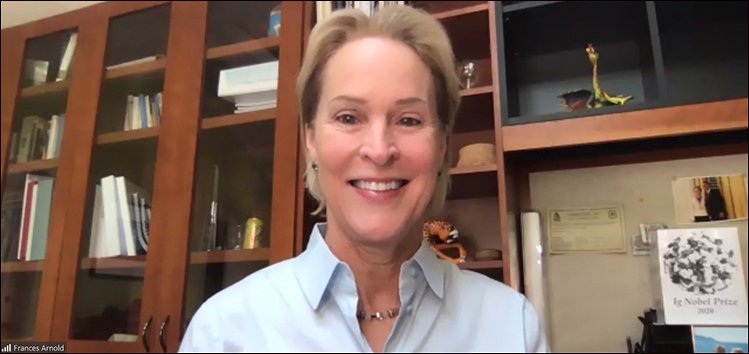Nobel Laureate Frances Arnold creates new enzymes by
[ad_1]

Mixing chemistry, biology and engineering, Frances Arnold tweaks enzymes present in nature to carry out new methods by altering their DNA.
Arnold, a Caltech chemical engineer with a Nobel Prize in Chemistry, scads extra awards and honors, and analysis citations by way of the roof, delivered a rousing digital lecture to some 700 listeners—virtually twice. “You missed a extremely nice lecture,” Arnold mentioned and smiled when she realized her web connection dropped shortly after her introduction and lasted virtually 20 minutes.
Unruffled, she restarted and delivered the Vanderbilt Faculty of Engineering’s 2020 fall John R. and Donna S. Corridor Engineering Lecture Tuesday, Sept. 15. Her lecture, “Innovation by Evolution: Bringing New Chemistry to Life” is a nod to her Nobel Lecture in 2018. Arnold is the fifth lady to win the Nobel Prize in Chemistry because it was first awarded in 1901.
Arnold developed a way within the 1990s referred to as directed evolution that has put the facility of evolution into chemists’ palms. Her pioneering work is impressed by nature, utilizing evolution to revamp enzymes to be used in biotechnology and creating totally new dimensions to protein chemistry. Arnold calls nature “a superb chemist and by far the very best engineer of all time.”
“Enzymes are difficult,” Arnold mentioned. “However nature has a beautiful design course of for manipulating DNA to realize helpful features, and that’s evolution.” Arnold used the instance of atrazine, an herbicide initially regarded as non-biodegradeable and in the end banned in Europe. Some found organisms have developed to degrade man-made atrazine and make a brand new supply of nitrogen to maintain themselves.
“Scientists have used evolution to switch the organic world on the degree of DNA, bettering corn and making poodles,” she mentioned, popping a slide with a photograph of canine, a white poodle within the forefront.
Arnold makes use of the method of evolution—mutation and pure choice—to compose new DNA in enzymes: Breed in a take a look at tube. Make mutations. Select the very best ones. Repeat. Arnold’s lab has generated microbes that do what organisms in nature have by no means been recognized to do. She and her crew reported using enzymes to catalyse the formation of carbon-silicon bonds, two ample Earth components, however such bonds aren’t naturally occurring. (Science, 2016)
Whereas others have contributed to the sector of directed evolution—and Arnold cites them—she developed the iterative strategies that mimic the random mutagenesis and choice present in nature and developed screening strategies to pick mutations for focused properties. Additionally, she selected to publish slightly than patent the processes so others may make new enzymes.
Arnold, the Linus Pauling Professor of Chemical Engineering, Bioengineering and Biochemistry at CalTech, has created enzymes for functions in various fuels, chemical compounds and prescribed drugs. She has cofounded three firms that use directed evolution to create enzymes: Gevo, a producer of biofuel and chemical compounds; Provivi, a specialist in unhazardous pest management; and Aralez Bio, which makes unnatural amino acids.
“As an alternative of asking what enzymes do within the pure world, we are able to now ask ‘What may they do?’” Arnold mentioned in her Nobel lecture, “A treasure trove of latest enzymes awaits discovery for finishing up chemistry that we couldn’t even ponder just some years in the past.”
Contact: Brenda Ellis, 615 343-6314
brenda.ellis@vanderbilt.edu
Posted on Thursday, September 17, 2020 in directed evolution, DNA, evolution, Frances Arnold, John R. and Donna S. Corridor Engineering Lecture, new-to-nature enzymes, Nobel Laureate 2018,Alumni, Chemical and Biomolecular Engineering, Dwelling Options, Information, Information Sidebar, Analysis
[ad_2]
Supply hyperlink